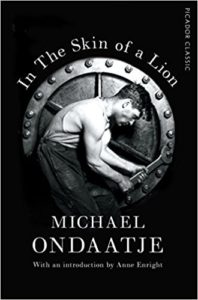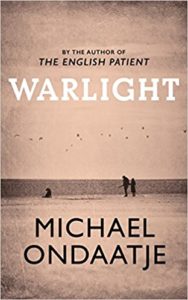Michael Ondaatje’s “Warlight”
( On Sunday, 27 May 2018, the online news portal Scroll published my review of Michael Ondaatje’s Warlight. Here is the original link. )
You return to that earlier time armed with the present, and no matter how dark that world was, you do not leave it unlit. You take your adult self with you. It is not to be a reliving, but a rewitnessing.
(p.114, Warlight)
Michael Ondaatje’s Warlight is narrated by Nathaniel, first as a teenager and then the older twenty-nine year old, recounting events that occurred towards the end of the second world war. Nathaniel and his older sister, Rachel, are told in 1945 that their parents are relocating from London to Singapore, ostensibly for their father’s work with Unilever. The children are to be left in the care of two men “who may have been criminals”.
It is wartime. Existing rules of conduct do not seem to be relevant any more — “we had broken free, adapting to fewer rules, less order”. Nathaniel writes “There are times these years later, as I write all this down, when I feel as if I do so by candlelight.”
The children continue to live in the house of their parents. It is an odd household, cobbled-together group, with “The Moth”, earlier a lodger, now their guardian. Drifting in and out are regulars like the Pimlico Darter, erstwhile boxer, now mixed up in the illegal world of greyhound racing, who has a string of girlfriends whom he brings over –“I like women smarter than me”. One of them is the inexplicably surprising choice of geographer and ethnographer Olive Lawrence, independent, self-sufficient, and who seems to exist “in a state of separateness from all the others”. Yet for the children once they were familiar with the ways of the Moth and the Darter — “they were to us wondrous doorways into the world”.
With the Moth and the Darter, Nathaniel and Rachel, learn about the flickering, shadowy parts of wartime London, which were carefully put down on a map by the teenager Nathaniel. Each week Nathaniel would draw detailed maps radiating out to the rest of the world making sure of any new alteration — “I needed a safe zone”. Yet the changes on the streets are plotted on the maps meticulously by Nathaniel though perhaps not so obvious to an untrained eye but “differences did exist in two seemingly identical panels”. Nathaniel’s desire to search for a safe zone stretches beyond the war years to adulthood when he decides to investigate the truth about his mother.
Back to the odd guardians of these children. They introduce Nathaniel and Rachel to a wondrously luminous yet shadowy world that consisted of the jubilantly illegal profession of greyhound racing, travelling the waterways of London by night delivering dogs, working at hotels, the world of theatre and opera. This apart from the world that wafted in with the visitors to their house at night such as Mr. Florence the beekeeper, shy Arthur McCash the limerick teller, and Citronella the couturier. “The house felt more like a night zoo,” Nathaniel says, “with moles and jackdaws and shambling beasts who happened to be chess players, a gardener, a possible greyhound thief, a slow-moving opera singer.”
Part of the richness of the novel comes from tiny, accurate details, such as of Rachel’s epileptic fits and the tenderness with which the Darter responds to them. He has learned his ‘medical’ knowledge by treating greyhounds or slipping a dog or two Luminal — a barbiturate used in the treatment of epilepsy — to make them drowsy before the start of a race. There are the details of the migrant staff at the Criterion where Nathaniel and the Moth are employed, the precision with which all of them work letting little slip of their true identities. For instance Mr. Harry Nkoma, a dishwasher at Sink One, a fabulous storyteller who spoke of the piano lessons he enjoyed with Mrs. Rafferty in the town of Ti Rocher, four thousand miles from Piccadilly Circus. It was a charming story heard till one day when “his educated hands riffling the keys in a sultry and wise way, so it was impossible not to be thereby amazed at the truth of what we had thought were his earlier fictions”. For Nathaniel, strangers replace family life. He learns a lot from them but can also keep his distance from them. He enjoyed his time in these half-lit moments. As the New York Times literary critic Dwight Gardner says of the author “He’s a devotee of curious detail.” ( “A Mother Keeps Wartime Secrets in Michael Ondaatje’s New Novel” NYT, Dwight Gardner, 7 May 2018). This is not surprising. In September 2017, Ondaatje said of his writing process, “During those early stages of handwriting the novels, I sometimes need a few visual breaks along the way. I might stick in someone’s poem fragment, just a few lines, or perhaps a stray visual image of a party at Oxford where quite a few are drunk that I came across in a magazine. There might be perhaps some subliminal influence.” ( “Michael Ondaatje opens archive to reveal his writing methods“, Alison Flood, The Guardian, 25 Sept 2017)
Then there is the story of the mysterious mother, Rose or ‘Viola’ as some remember her. After their father left for Singapore the teenagers watched their mother prepare for her imminent departure too by meticulously packing a large trunk for life in the tropics. Long after their mother’s departure the children discover her packed trunk in their basement though they had said their good-byes to their mother. The mystery about their mother was put together like a patchwork quilt years later by Nathaniel when he was recruited to work in the Foreign Office archives. He hoped that ten years after his mother’s death he would glean more information about Rose but it was not very forthcoming. Instead quite by accident he meets an old acquaintance of his mother, Marsh Felon, in the corridors of the building. Marsh Felon was a rural boy who belonged to a family of roof thatchers. He was eight years older to Rose but they met when Felon and his family came to fix Rose’s family home in Suffolk. It is later that Nathaniel discovers that his mother was recruited by Marsh Felon, one of the best of British Intelligence, the “war-skilled gentry”.
 In her 2007 introduction to In the Skin of a Lion, Anne Enright writes “Ondaatje is much praised for the way he “decentres” history” and later “He is the presiding genius of a kind of clear-eyed male fiction”. Both statements hold true a decade later with Warlight. As Hermione Lee in her New York Review of Books article says of Ondaatje, “He casts a magical spell, as he takes you into his half-lit world of war and love, death and loss, and the dark waterways of the past.” (NYRB, Hermione Lee, “The Mists of time”, 24 May 2018)
In her 2007 introduction to In the Skin of a Lion, Anne Enright writes “Ondaatje is much praised for the way he “decentres” history” and later “He is the presiding genius of a kind of clear-eyed male fiction”. Both statements hold true a decade later with Warlight. As Hermione Lee in her New York Review of Books article says of Ondaatje, “He casts a magical spell, as he takes you into his half-lit world of war and love, death and loss, and the dark waterways of the past.” (NYRB, Hermione Lee, “The Mists of time”, 24 May 2018)
There are layers and layers of details about each character, descriptions of the topography, the immense numbers of landscapes that are documented or referred to via the various maps mentioned, all of which display the ugly underbelly of a broken society, a war torn community, a ragtag mix of individuals drifting through life till they find their anchor. It is not a story of the heroic soldier normally associated with war fiction, it is of the anti-hero like Felon, or of seemingly societal detritus like the Moth and Darter but who later it is found are Rose’s colleagues, so are leading double lives — commoners recruited to be spies during active war. Ondaatje manages to etch all this in a lyrical novel, almost as if it is poetry in prose. Once again Anne Enright is spot on when she says “It makes me think you can progress through time like a poet. It makes me think you can do whatever the hell you like with time.”
In an interview to CBC Radio, Michael Ondaatje said “Warlight is not a war novel. ‘Warlight’ is an invented word. At one moment in the book, I describe the River Thames at night during the war. With all the arches of a bridge crossing the river, there is only one arch that can be used safely. There is a small, yellow light at the top of that arch — an important clue for those using the river at night. That small, lit thing gives you an unusual perception of a time and a place. I wanted to write a tone or a kind of light to suggest that time for those around before and after the war.” ( CBC Radio, “Why Michael Ondaatje thinks his latest book, Warlight, is more than a war novel”, 14 May 2018)
Warlight is an exceptionally beautiful novel while exploring those fuzzy liminal edges of existence that become apparent during a conflict whether in the flicker of the small, yellow light or metaphorically speaking. It makes visible the “unknown brave old world”.
Michael Ondaatje Warlight Jonathan Cape, an imprint of Vintage, London, 2018. Pb. pp. 290 Rs 599
Michael Ondaatje In the Skin of a Lion ( with an introduction by Anne Enright) Picador Classic, an imprint of PanMacmillan, London, 1988, rpt 2007. Pb. pp.260 Rs 399
20 May 2018








